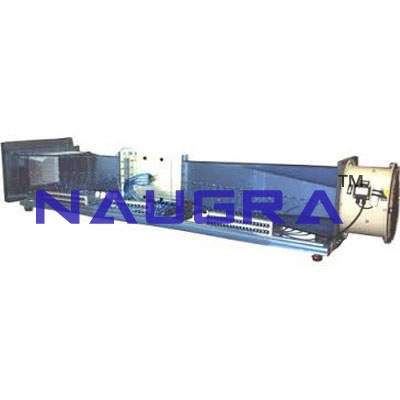- Civil Lab Mechanical Lab Engineering Lab Equipments
- sales@didacticlabequipments.com

CAT NO: DIDACTICNLE-Export-205111
EXERCISES AND PRACTICAL POSSIBILITIES
Some Practical Possibilities of the Unit:
1.-Comprehensive study of subsonic aerodynamics and air flow studies.
2.-Flux in a nozzle. Determine the characteristics of the pressures field in a nozzle.
3.-Flux
in an nozzle. To observe the local characteristics, depending on
whether the walls have a curvature or not, as well as what happens in
the inlet and outlet
areas of the contraction.
4.-Flow of an uniform current around a cylinder.
5.-To determine the form of the field of pressures around a cylinder on which a perpendicular to the axis current impacts.
6.-To determine, by the detachment type, if the boundary layer finally becomes turbulent or remains laminar.
7.-To determine the coefficient of resistance of the cylinder, for the described situation of flow.
8.-To relate all the above mentioned with the Reynolds’s number.
9.-Flow of an uniform current around a concave and a convex semi-cylinder.
10.-To determine the field or pressures in the two semi-cylinders,the concave one and the convex one.
11.-To determine the coefficients of aerodynamic resistance in the concave and the convex semi-cylinders.
12.-Aerodynamics forces due to the wind on house.
13.-Measurement of pressure distribution around body two-dimensional.
14.-Flow visualization studies.
15.-Velocity and pressure distribution measurement using a Pitot’s Tube.
16.-Sensors calibration.
Practices to be done by PLC Module (PLC-PI)+PLC Control Software:
17.-Control of the unit process through the control interface box without the computer.
18.-Visualization of all the sensors values used in the unit process.
19.-Calibration of all sensors included in the unit process.
20.- Hand on of all the actuators involved in the unit process.
21.-Realization
of different experiments, in automatic way, without having in front the
unit. (This experiment can be decided previously).
22.-Simulation
of outside actions, in the cases do not exist hardware elements.
(Example: test of complementary tanks, complementary
industrialenvironment to the process to be studied, etc).
23.-PLC hardware general use and manipulation.
24.-PLC process application for unit.
25.-PLC structure.
26.-PLC inputs and outputs configuration.
27.-PLC configuration possibilities.
28.-PLC program languages.
29.-PLC different programming standard languages (literal structured, graphic, etc.).
30.-New configuration and development of new process.
31.-Hand on an established process.
32.-To visualize and see the results and to make comparisons with the unit process.
33.-Possibility of creating new process in relation with the unit.
34.-PLC Programming Exercises.
35.-Own PLC applications in accordance with teacher and student requirements Fluid Mechanics Lab Equipments manufacturers.
